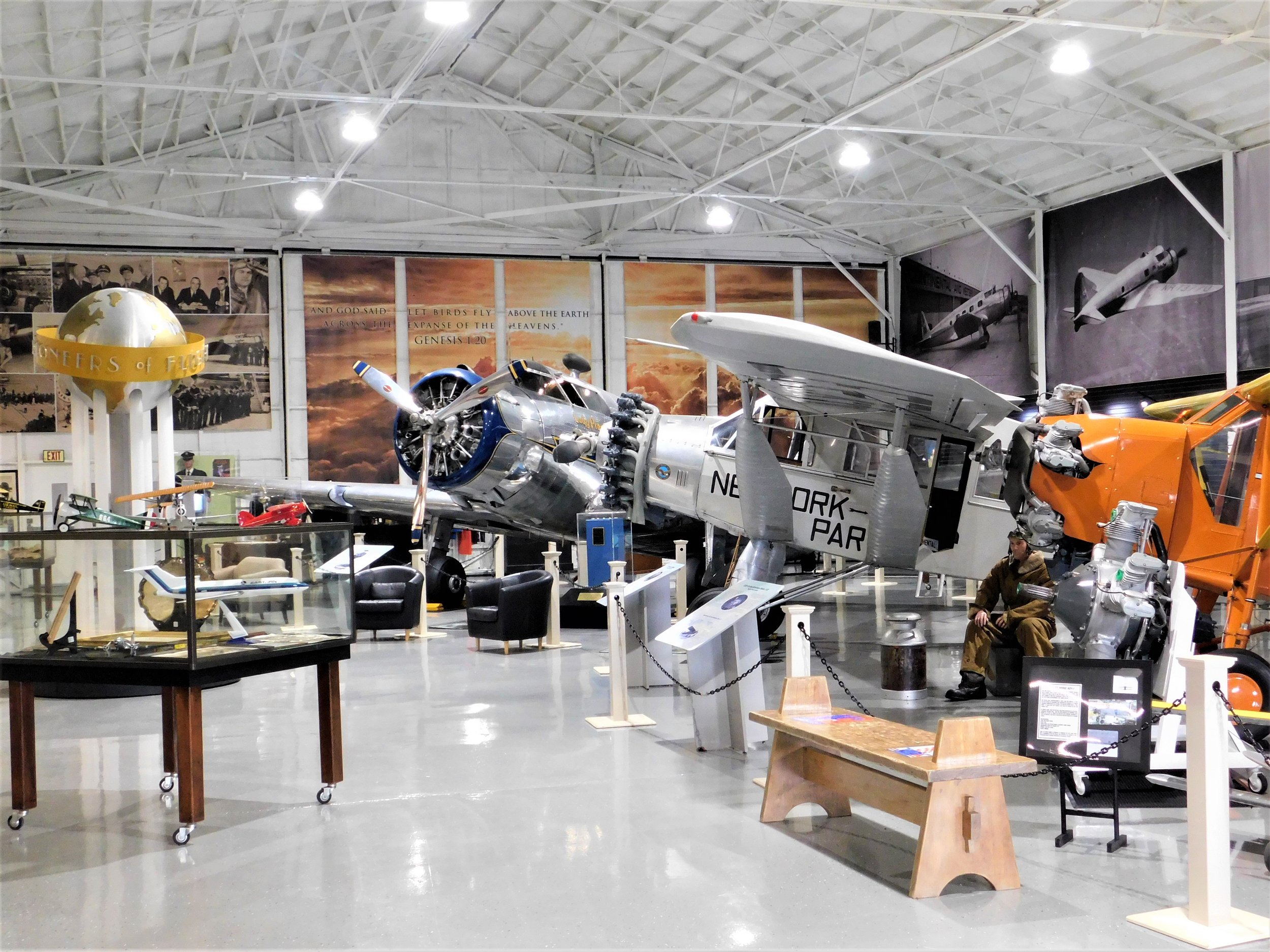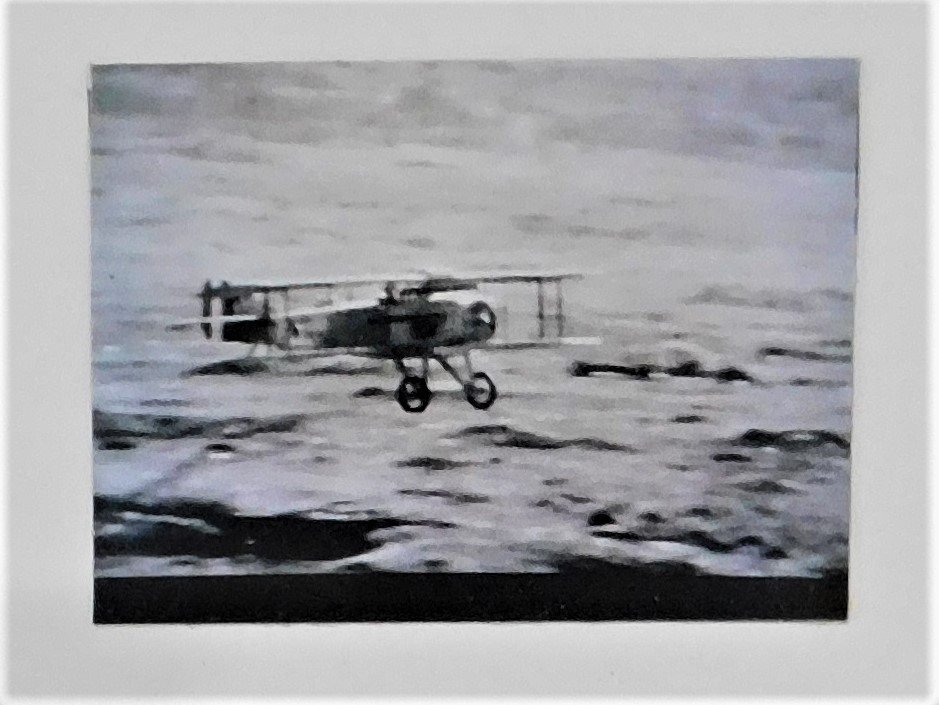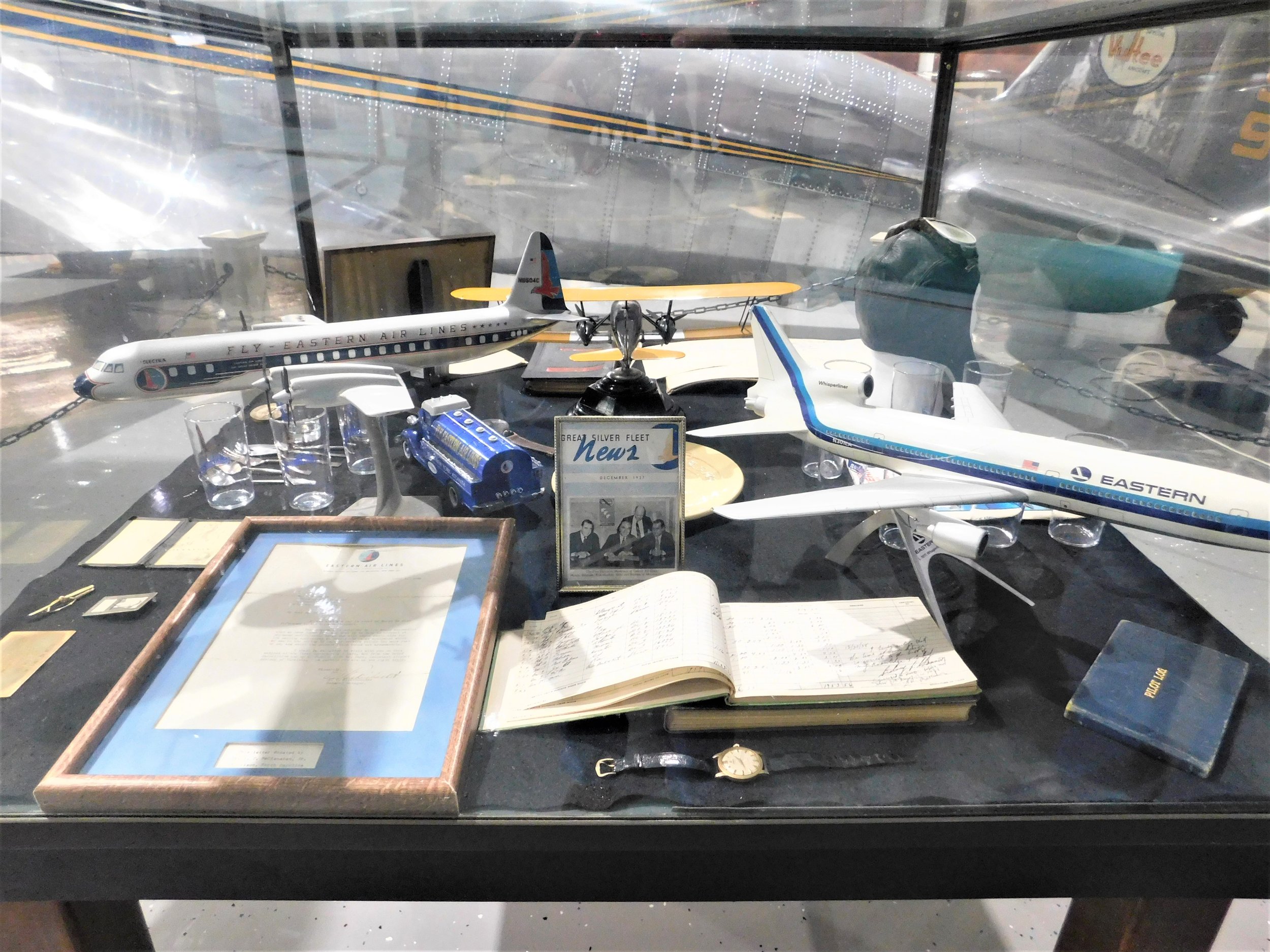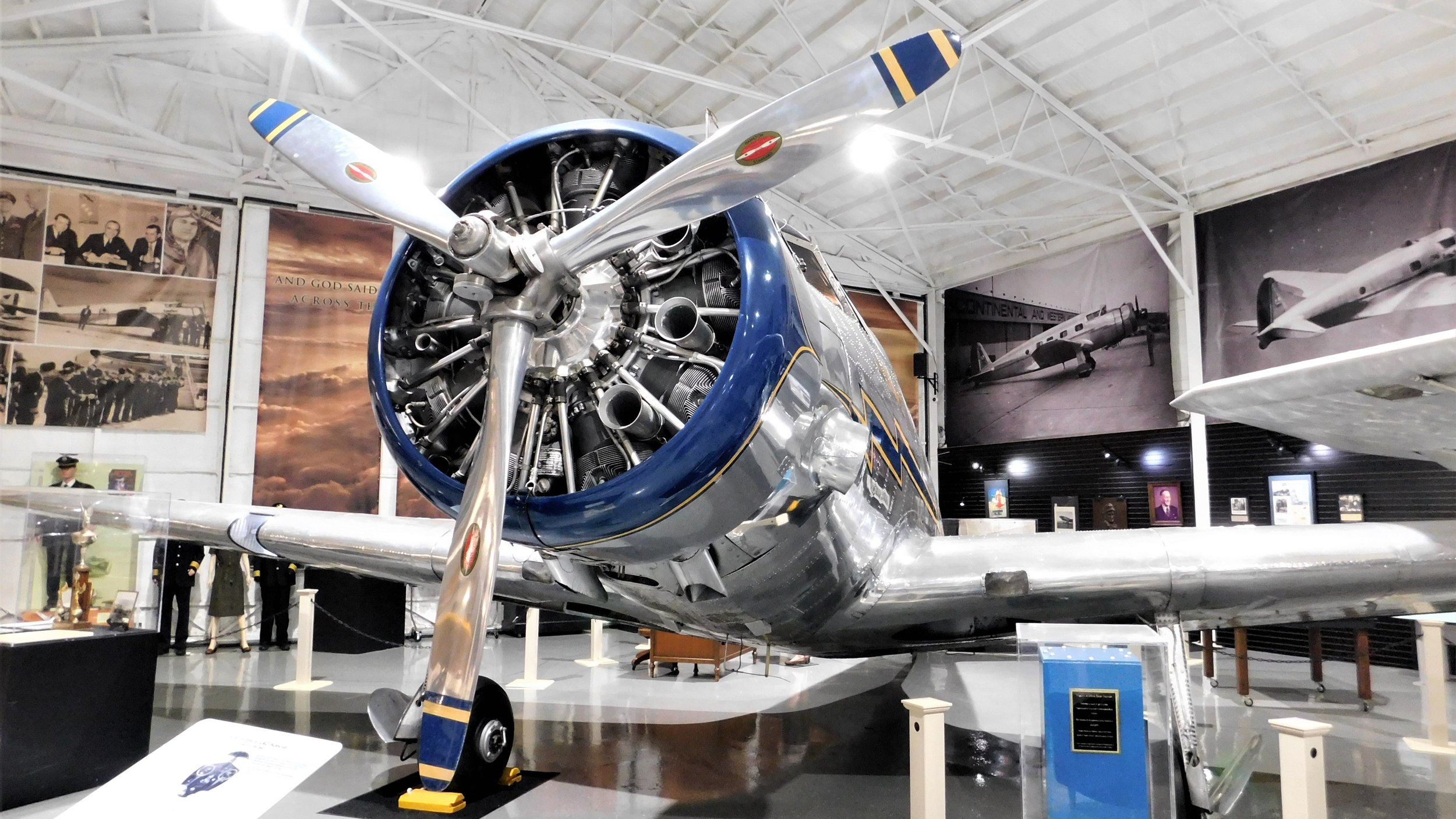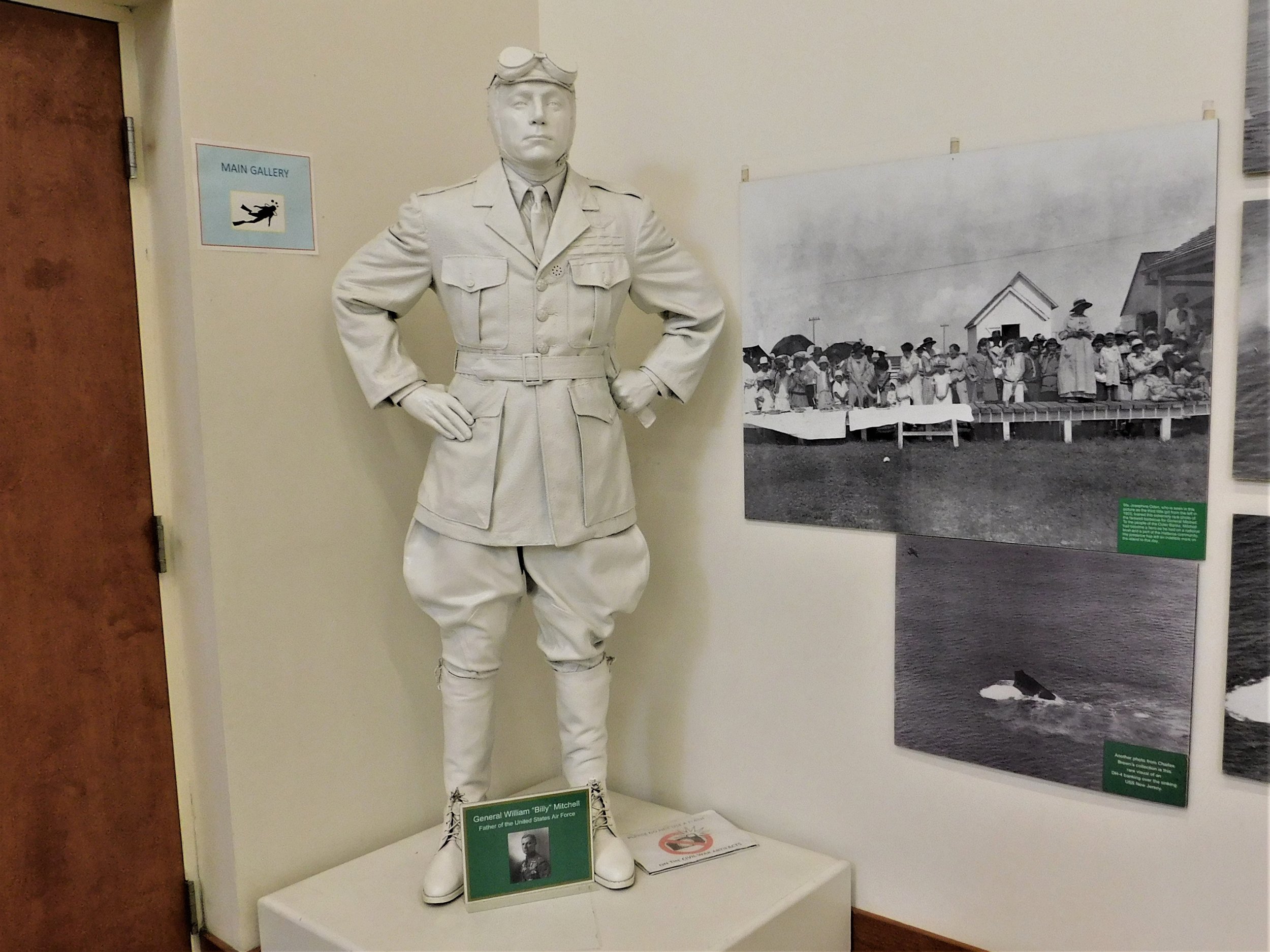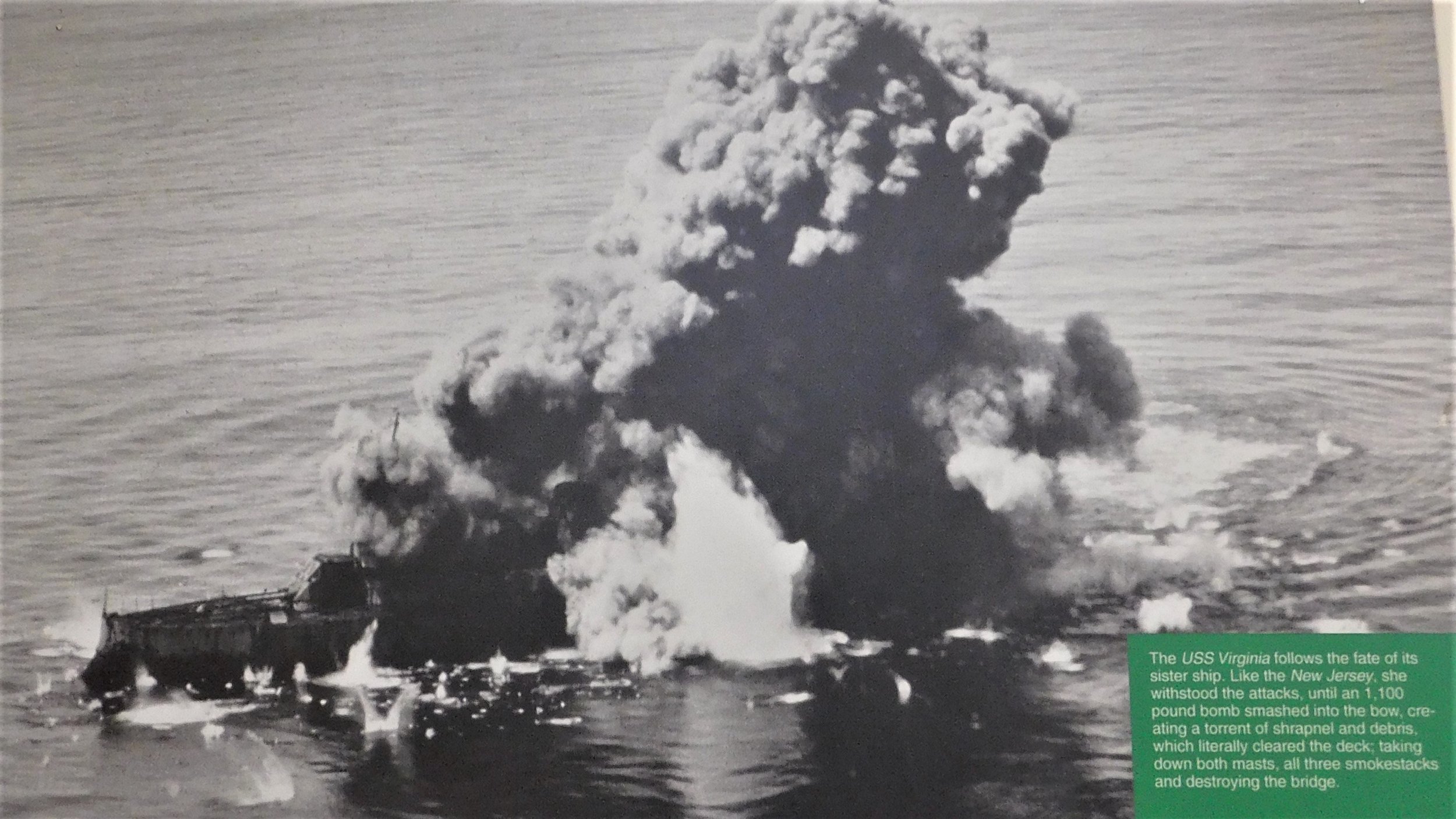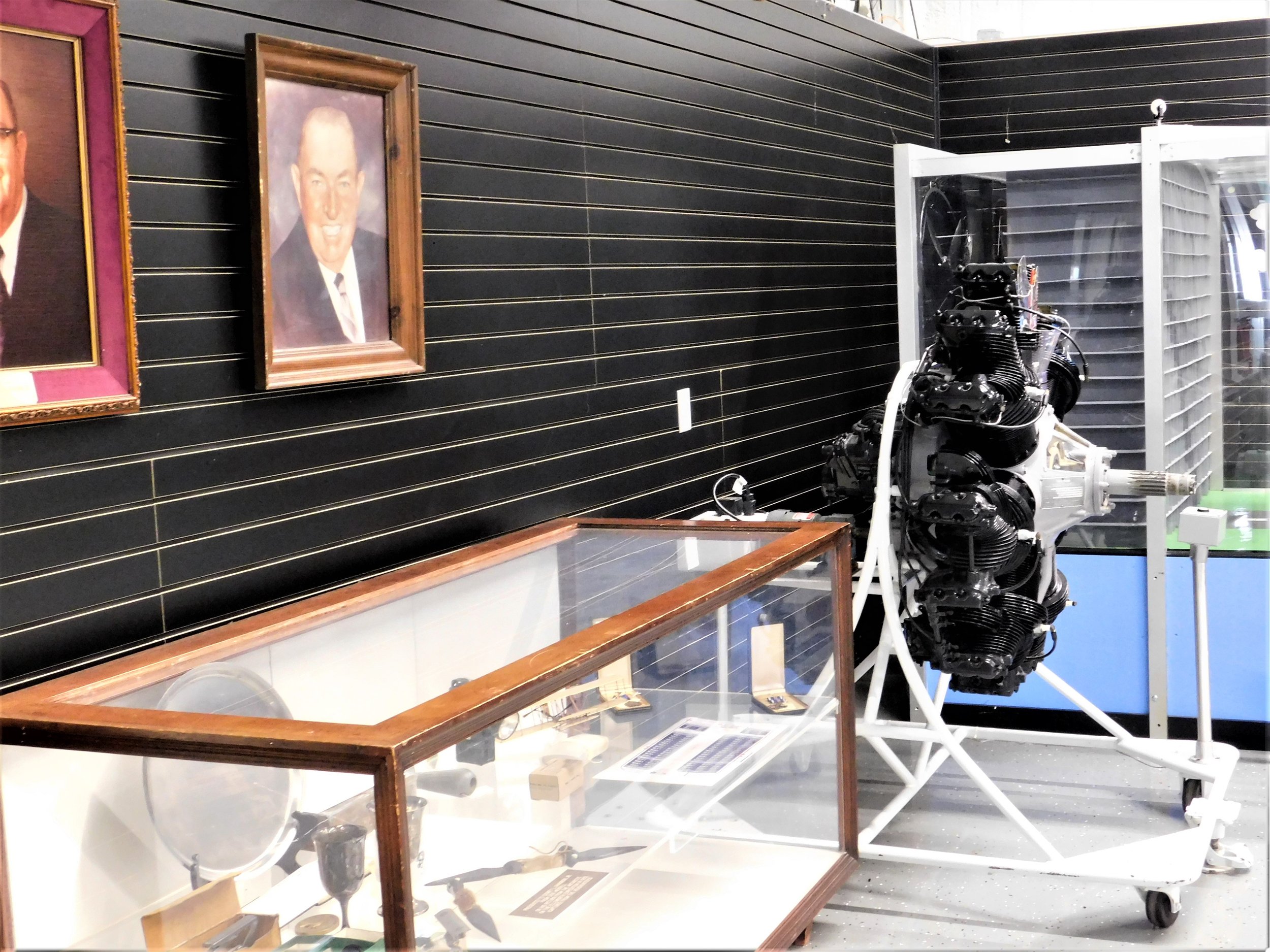The Shannon Air Museum
Issue 33 A visit to the The Shannon Air Museum, Fredericksburg, Virginia April, 2022
———————————————————————
In 1927, Paramount Pictures produced the WW-I silent movie “Wings” starring Clara Bow. Partly filmed at Kelly Field in San Antonio, the movie featured planes and pilots of the United States Army Air Corps and the film received much acclaim for its technical prowess and realism. In 1929, “Wings” received the very first “Best Picture” award from the Academy of Motion Picture Arts and Sciences (the only silent film ever to do so). There were over 300 planes used during the production of the movie, and one of those planes, a Spad VII, survives today. It is fully restored and on display in the Shannon Air Museum in Virginia.
Spad in flight during the production of “Wings” Photo courtesy of Shannon Air Museum
—————————————————————
The history of Shannon Airport goes back to the 1950s when aviation enthusiast, Sidney Shannon junior, opened the field near Fredericksburg, Virginia. Shannon’s father, Sid senior, was instrumental in the founding of Eastern Airlines with Eddie Rickenbacker. The airport became a popular general aviation airport with air shows and fly-ins, and it developed a great general aviation atmosphere.
In 1976, the Shannon Air Museum opened. Sid Shannon was interested in the Golden Age of Flight and built a collection of rare and unique aircraft from the 1920s and 30s. After Shannon’s death in 1981, the airport fell on hard times. The museum collection was eventually moved to the Virginia Aviation Museum at the Richmond airport, which opened in 1986. Luckily, the Shannon airport was rescued from probable redevelopment by Billie Toombes and remained a general aviation airport. In 2014, the airport was bought by local entrepreneur Luke Curtas and his wife Kim. When the Richmond Museum closed in 2016, Curtas began looking into the idea of returning some of the aircraft to Shannon. With the help of a volunteer maintenance team, the Shannon Air Museum reopened in 2017. The new version of the museum continues the vision of Sid Shannon by concentrating on aircraft from the Golden Age of Flight.
The plane that was used in the movie Wings is a Spad VII that was built in 1917. The Spad series of aircraft were probably the most successful planes of World War I and were flown by most of the Allied countries, including by three American squadrons. The name Spad derives from the manufacturer, Société Pour L'Aviation et ses Dérivés.
Of the almost 6,000 Spads built, around 100 were built in England by Mann, Egerton & Company Ltd. This particular Spad, B9913, was one of those manufactured in England and it was one of 19 sent to the US Army’s pursuit gunnery school in San Diego as an advanced fighter trainer. It was completely restored in 1973.
As we have seen in other museums, the majority of WW-I planes on display are replicas. Replicas are a great way to illustrate WW-I aviation, but to see an original plane like this is certainly more historically interesting.
The 1927 Pitcairn Mailwing PA-5 was a very successful open cockpit bi-plane built in Bryn Athyn PA. In September of 1927, Harold Pitcairn formed Pitcairn Aviation and, in May 1928, he won the contract for airmail route CAM 19. The new route from New York to Atlanta made a number of stops including Philadelphia, DC, and Richmond. In December of 1928, Pitcairn added CAM 25 which went from Atlanta to Miami and set the stage for the eventual route structure of Eastern Airlines. In 1929, Pitcairn sold his airline to Clement Keys and North American Aviation. In 1930 the name was changed to Eastern Air Transport, eventually becoming Eastern Air Lines.
The Travel Air manufacturing company was founded in Wichita in 1925. Founding members were Walter Beech, Clyde Cessna, and Lloyd Stearman- quite a group of general aviation names. Their third design, introduced in 1927, was the Travel Air 2000. The Travel Air series of aircraft were popular on the barnstorming circuit, replacing surplus WW-I aircraft such as the Curtiss Jenny. Over 1,000 Travel Airs were built (the number is unclear; it may have been as many as 2,000). Travel Airs were used in a wide variety of roles including airmail flying and early air transport operations.
The museum’s Travel Air 2000 is powered by a Curtiss OX-5 engine. The 2000 is known as “Old Elephant Ears” for the large balance horns on the ailerons.
Edward Heath designed his first plane in 1909 and later worked as a mechanic for Glenn Curtiss. In the 1920s he was a successful air racer and, in 1926, he came up with a design for a very light and simple plane he could sell in kit form. This example is a 1928 Heath Super Parasol.
Heath died in a crash in 1931 and, in 1935, the company was sold to Edward Anthony. Anthony developed the very successful Heathkit line of electronics kits and the company still exists today.
We have seen a Curtiss Robin in several museums in this series (Issue 12 & Issue 32). Over 700 of the three-place aircraft were built. Robins helped usher in passenger flying, including being the first plane for Cuba’s national airline, CUBANA (in 1929). In 1935 a Robin was used to set an endurance record of 27 days aloft and a Robin was the type of plane flown from New York to Ireland by “Wrong Way” Corrigan in 1938.
This particular Robin is a 1929 J-1D, powered by a Wright Whirlwind J-6 5-cylinder radial. It was restored to this beautiful condition in 1969.
Although all the aircraft in the collection are fully restored, none of them are maintained in flying condition. The museum, however, has recently acquired this DC-3 “Stars and Stripes”. It is currently being refurbished to flying condition, to represent the museum in air shows and fly-ins. Built in 1940, this DC-3 was originally delivered to Braniff Airlines. Airport owners Luke and Kim Curtas, were interested in this particular DC-3 because it had flown for a while at Eastern Airlines, making the connection to the airport founder’s father, Sidney Shannon senior.
Although the main focus of the Shannon Air Museum is the beautiful aircraft from the Golden Age of Flight, there are a number of other interesting displays around the building. This typical tool box from the era adds to the atmosphere.
This portion of the structure of a wing gives visitors a good look at how aircraft of the time were constructed.
There is also quite a bit of Eastern Airlines memorabilia on display. Many of the items are from the personal collection of Richard Merrill. We’ll talk more about Dick Merrill a little later.
The museum is also home to the Virginia Aviation Hall of Fame. The Hall of Fame was created to “honor Virginians who have made significant and lasting contributions to aviation while preserving their stories for future generations”.
The Aeronca Aircraft Corporation was founded at Lunken Airport in Cincinnati in 1928. Their first aircraft, a C-2, first flew in 1929. Aeronca sold 16 C-2s, and 400 of its derivative, the C-3. The C-2 is a very basic plane which evolved from a design by Jean A. Roche, who is honored in the Virginia Aviation Hall of Fame. The simple design made the plane inexpensive and it was successful, even during the Depression years. It had several nicknames including “Flying Bathtub”.
The museum’s C-2 has an interesting history. It was originally built (likely in 1931) as a version of a C-1- a clipped wing Cadet. Its wing-span was 7 feet shorter than a regular Cadet, making it 15 knots faster, but, presumably, more difficult to fly. In 1932 it was converted to a C-2N which was a deluxe version of the C-2 Scout. The plane was rebuilt to its current standards in 1962.
The Standard E-1 trainer was designed as a fighter aircraft and first flew in 1917. It proved less than adequate as a fighter and was re-designated a trainer. The E-1 was built in Elizabeth, NJ and a total of 168 were built, with 128 being used as trainers. They were powered by either a La Rhone or a Gnome rotary engine. Built in 1918, this E-1 was found by Sidney Shannon in Dayton in 1950, either in a barn, or in a flower shop, depending on where you read. Like the Spad VII, this is a rare original WW-I aircraft.
This Bellanca CH-400 was built in 1927 as a CH-300. It had served in Alaska and was rescued from a glacier in 1964. In 1976 it was re-built to the specifications of a CH-400, mainly by swapping the original Wright J-6 (330 HP) with a more powerful Pratt & Whitney Wasp (420 HP).
The Bellanca is painted in the scheme of Clarence Chamberlain’s record setting Bellanca WB-2. Just one WB-2 was built and the CH-200, CH-300, and CH-400 were follow-on models. Chamberlain made two record setting flights in the WB-2, including a non-stop flight from New York to near Berlin, just two weeks after Charles Lindbergh’s famous flight. Unfortunately, the original WB-2 was destroyed in a fire at Bellanca Field in the 1930s. The story of the Chamberlain flight was told in issue 27, The Bellanca Airfield Museum.
Sitting next to the Bellanca is a unique aircraft representing another record-setting transatlantic flight.
The centerpiece of the museum is this beautifully restored 1936 Vultee V-1AD Special. Of the 25 Vultee V-1s built, this is the only remaining example.
Captain Dick Merrill was an aviation pioneer with direct connections to Eastern Airlines and to Sid Shannon. A number of aspects of his colorful career are told at the museum, and there are several display cases of his personal memorabilia. The Vultee memorializes one of his many accomplishments.
Dick Merrill’s desk next to the Vultee
The 1920s and 1930s are known as The Golden Age of Flight for many reasons. Barnstorming, air shows, air racing, the introduction of air mail service, and passenger air service, all contributed to the widespread excitement about aviation. During the era, there were daily newspaper articles about new records that were being set and many of these accomplishments resulted in monetary prizes. Charles Lindbergh won the Ortieg prize and the $25,000 that went with it for the first transatlantic flight. In 1936, Dick Merrill came up with the idea of setting a record for the fastest round-trip transatlantic flight, which had never been done. He teamed up with singer Harry Richman who had made his fortune with the hit song “Putting on the Ritz”. Richman bought a Vultee V-1 and the pair planned for the record setting flight. At the time, CAA (predecessor to the FAA) approval was required for such a flight. The CAA had recently imposed regulations that severely limited the use of single engine aircraft for passenger flights (effectively ending the success of the Vultee and the Pitcairn Mailwing as airliners). To ease the concerns of the CAA about the proposed single engine Atlantic crossing, Merrill and his crew came up with the idea of filling all empty spaces on the plane with ping pong balls.
The idea was that, if they went down in the ocean, the ping pong balls would keep the Vultee afloat until they were rescued. They got the CAA approval. It turned out that the round-trip crossing was successful and the theory was never put to the test. There wasn’t a monetary prize for this record setting round-trip, but there was plenty of publicity, and it is said that Harry Richman made enough money selling autographed ping pong balls for $2 each to recoup the entire cost of the trip. The Vultee is painted in the paint scheme of Harry Richman’s Vultee “Lady Peace II”.
Dick Merrill was notable for numerous other accomplishments in aviation. Flying air mail route CAM 19, he became the highest paid air mail pilot of the time. The year after the famous “Ping-Pong Flight”, Merrill teamed with Jack Lambie to fly a Lockheed Model 10E Electra on another round-trip across the Atlantic.
That flight was known as the "Anglo-American Goodwill Coronation Flight", which was recognized as the first commercial round-trip across the Atlantic. On the way over they carried photos of the Hindenburg disaster- the first to arrive, and be published, in Europe. On the way back, they brought the first photographs of the coronation of King George VI for the U.S. newspapers. There was even a feature movie made of the flight, all of which is told in original photos and memorabilia.
Dick Merrill had a number of other accomplishments including being President Eisenhower’s personal pilot, and serving as curator of the Shannon Museum. Merrill was also a senior and highly respected pilot with Eastern Airlines and there are many items on display telling the story of his long and illustrious career.
The Vultee in the museum is not the actual plane flown by Merrill on his transatlantic flight, but it does have its own notable history. This Vultee was custom built in 1936 for publisher William Randolph Hurst. In 1939 it was sold to a Panamanian airline and it served the US Government in Central America during WW-II. It went through several private owners and was restored in the 1960s, taking to the air again in 1971.
Sid Shannon junior then bought the historic plane, renaming it “Lady Peace II” in honor of Dick Merrill’s famous flight. You can see from the interior that it has been beautifully restored to its original condition.
-----------------------------------------------
The Shannon Air Museum is wonderful museum to visit with a number of significant planes on display, all in restored condition.
Many thanks to Blair Gloss, my guide through the museum.
--------------------------------------
To learn about what to do in the local area, museum hours and costs as well as books to read and other interesting odds and ends, keep reading! At the end you will find a photo gallery of the entire museum.
PLANNING YOUR VISIT
The museum is open Tuesday-Saturday from 10am-4pm
Visiting is by guided tour only with the last tour starting by 2pm. Guests arriving later than 2pm are not guaranteed admittance.
General Admission $15 (Ages 13 and up)
Ages 12 & Under $9 (Must be accompanied by an adult)
Ages 3 & Under free
5% discount to all Seniors (65+), Active-Duty Military, and First Responders - Thank you for your service!
FLYING IN
Shannon Airport (KEZF) has a 3,000’ paved runway (6/24) and a 1,300’ grass runway (15/33)
There is an RNAV and NDB approach to runway 24. Several arrivals (STARS) to the DC area can be flown into Shannon.
The airport has a full service FBO, including rental cars. The museum is right next to the transient ramp.
LOCAL ATTRACTIONS
Fredericksburg was the site of several battles during the Civil War and, in fact, the airport is right next to one of the battle sites. https://fxbg.com/things-to-do/history/civil-war/
WHERE TO EAT
After my tour, I had lunch in the Robin’s Nest Café next door. It has a great period look, a full menu, and excellent service.
SUGGESTED READING
In the summer of 1923, General Billy Mitchell took a group of Martin Bombers to Cape Hatteras on the Outer Banks of North Carolina. His goal was to prove the capabilities of strategic bombing. There has not been a lot written about Mitchell’s activities on the Outer Banks but I recently heard about The Lion Killers by William Schwarzer. This well written monograph has a lot of interesting insights and is full of great original photos. For more about Mitchell’s time on the Outer Banks, see The Graveyard of the Atlantic Museum, below.
When I was at the The Graveyard of the Atlantic Museum I met Education Director, Mary Ellen Riddle, who recommended another book about Mitchell Billy Mitchell- founder of our Air Force and prophet without honor by Emile Gauvreau and Lester Cohen. Written in 1942, it is a real time analysis of the predictions that Mitchell made about air power before his death in 1936. Gauvreau and Cohen were close associates of Mitchell and were given a number of unpublished documents by Mitchell. This is a really intriguing book written in the shadow of World War-II. Thanks Mary Ellen!
MUSEUM WEBSITE
UP NEXT
The Patuxent River Naval Air Museum, MD
MUSEUMS ARE WHERE YOU FIND THEM
This segment is dedicated to finding interesting aviation artifacts that are in public view- but not in an aviation museum. If you see one send a photo!
Located at the end of Cape Hatteras, The Graveyard of the Atlantic Museum tells the story of the many ships that have been lost off the treacherous coastline of the Outer Banks of North Carolina. The stories include the five U-Boats that were sunk off North Carolina during WW-II. On display is an Enigma code machine that was recovered from one of the U-Boats.
Also featured in the museum is extensive coverage of the flights of Billy Mitchell in 1923. Mitchell’s planes flew from a sandy strip just a short way from the museum.
The original photos do a great job of telling the story of Billy Mitchell’s dramatic accomplishment of finding and sinking a number of surplus Navy ships.
The Graveyard of the Atlantic Museum is a really interesting place to visit to see the Billy Mitchell display and many others.
https://graveyardoftheatlantic.com/
PHOTO GALLERY
click to enlarge
Issue 33, Copyright©2022, all rights reserved. Except where noted, all photos by the author.
